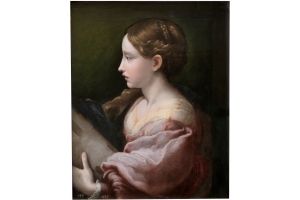


Jan de Bisschop was the son of Harmen Jansz. de Bisschop and Aaltje Adriaensz. van Noort. Jan preferred to call himself Episcopius (Latin for Bishop) as he had a strong preference for the latin language. He is assumed to have been an apprentice of Bartholomeus Breenbergh (Deventer, 1598-Amsterdam, 1657), though he was a dillettante. Jan studied Law in Leyden after which he settles as a lawyer in The Hague in 1652. He married Anna van Baerle (1615-1676) in 1653. In The Hague de Bisschop held close connections and friendship with the Huygens family, especially with Constantijn Huygens Jr (1628-1697).
Together with Jacob van der Does Sr., Maerten Lengele, Willem Doudijns and probably Constantijn Huygens Jr. as well, Jan de Bisschop founded a private drawing academy to promote Classicism.
De Bisschops most important publications on Claccisism would follow several years later with Signorum veterum Icones after classical sculptures in Rome and Paradigmata Graphices Variorum Artificium with etchings after drawings by Italian Masters. This second publication unfortunately unfinished due to de Bisschops premature death.[1][2]
Jan de Bisschop died of tuberculosis in 1671, after which his drawings and prints were auctioned. The copper plates for his etchings were purchased by Nicolaus Visscher who published a new edition of his graphics (Icones and Paradigmata).
Jan de Bisschop started copying after paintings by 16th and 17th century Masters around 1655. His goal was to recreate the original painting fully respecting the artists style and rendering, though translated into another medium with brush and ink on paper.
Actually, he was the very first to translate oil paintings into large size washed drawings. During the 16th century this manner of copying was applied but exclusively for copying sculptures and reliefs. His aim was to transfer the paintings as truthful as possible into drawings in black chalk and wash. These drawings often are sources of valuable information and sometimes the only remaining resources for paintings which got lost in the past. De Bisschops' copies were so highly esteemed, Arnold Houbraken even decided to mention Jan de Bisschop in his "Groote Schouburgh, 1721".
This drawing is part of a group of eight drawings, who were given to de Bisschop's intimate friend Constantijn Huygens Jr. (1628-1697) and were inherited by descent untill they appeared on the market recently. The drawings show de Bisschop at his very best and depict copies of paintings and sculptures after his most beloved artists alike Hans Holbein, Anthony van Dyck, Raphael, Titian, Tintoretto, Giulio Romano and de Ribera. Apart from few exceptions de Bisschop copied after the original works of art, which were part of famous collections such as the Royal House of Orange, Lady Arundel and Jan Six.
The present drawing, depicting Saint Barbara was erroneously annotated "Giulio Romano" by Constantijn Huygens Jr. Wallerant Vaillant, who used de Bisschop's drawing as the original after which he engraved his mezzotint of Saint Barbara and whom is known to have engraved frequently after the original drawings by Jan de Bisschop after 1665, has given the painting to Raphael, just like Jean Dubois, who engraved the same subject. Though.....the original painting by Raphael appears untraceable and we do find a matching painting by Parmigianino in the collections of the Prado Museo Madrid. Hendrick Bary (1640-1707) also engraved after drawings by de Bisschop. Sir. Peter Lely (1618-1680) was a great admirer and collector of these drawings by Jan de Bisschop.[3][4][5]
Saint Barbara
She lived in the third century in Nicodemia or Heliopolis and was the daughter to the rich pagan Dioscures. Barbara's father tried to hide his daughter from all worldly influences and locked her in a tower. Despite her father's attempt to she got into contact with Christianity and as a symbol had a third window added to her tower. She was tortured to leave Christianity and when she refused was decapitated by her father. Being a martyr and patroness for bell founders, mine workers, artillerymen and those who work with explosives, Barbara is often depicted with her tower with three windows as symbol of the Holy Trinity.
[1] Renske E. Jellema, Michiel Plomp, Episcopius / Jan de Bisschop; advocaat en tekenaar / lawyer and draughtsman. Waanders Uitgevers, Zwolle / Museum het Rembrandthuis, Amsterdam, 1992.
[2] Jan de Bisschop, Jan G. van Gelder, I. Jost, Jan de Bisschop and his Icones & Paradigmata. Classical Antiquities and Italian Drawings for Artistic Instruction in Seventeenth Century Holland. Davaco Publishers, Doornspijk, 1985.
[3] Wallerant Vaillant (1623-1677), Heilige Barbara (after Rafaël). Mezzotint, 163 x 131 mm. Hollstein Dutch 35-1. Rijksmuseum, Amsterdam. Inv. RP-P-OB-17.419
[4] Jean Dubois, Heilige Barbara ( after Rafaël). Engraving and etching, 302 x 205 mm. Hollstein Dutch 1. Rijksmuseum, Amsterdam. Inv. RP-P-BI-1960
[5] Parmigianino, Girolamo Francesco Maria Mazzalo, Saint Barbara. Museo Del Prado, Madrid, Spain. Oil on panel, 48 x 39 cm. Inv. nr. P000282